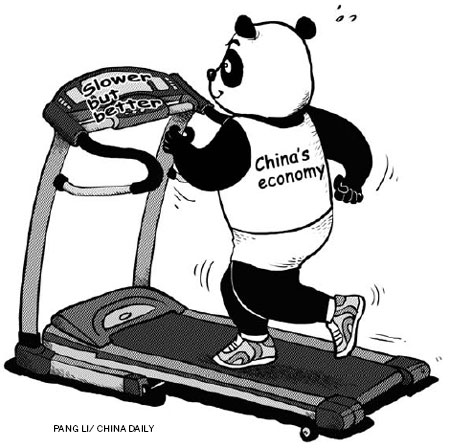
The once-in-a-decade leadership transition in China has triggered a lot of speculation over its possible impact on the country's economic policy. Starting with the macroeconomic policy stance, some observers think a major stimulus package is on its way after the new leadership is unveiled during the 18th National Congress of the Communist Party of China.
My colleagues and I at the Royal Bank of Scotland do not think so. In our view, a stimulus package has not come because policymakers are broadly comfortable with the growth outlook and now more concerned about the quality of growth. They are also still dealing with the negative consequences of the previous stimulus package and have somewhat greater tolerance for lower growth than in 2008.
Indeed, there are increasing signs that, after a steady economic slowdown through mid-2012, economic growth has bottomed out, even though we do not expect a rapid rebound in growth. Given this outlook, we do not expect a major economic stimulus ahead, although we think the macro-policy will remain supportive to growth.
In the monetary area, while we expect monetary conditions to be kept accommodative, we do not see much room anymore for interest rate cuts. In the fiscal area, we expect a continued constructive approach to infrastructure projects and some pro-consumption measures to be included in the 2013 budget.
While there is reasonable agreement among economic and financial reforms experts on the elements of the policy agenda, the question is what will be the impact of the leadership transition on its orientation, emphasis and speed.
The reform agenda includes a broad set combining economic rebalancing, industrial upgrading and sustaining growth. One set of reforms is meant to channel resources to new and growing sectors, products and services.
They include reforms to increase prices and taxes of industrial inputs to reduce the subsidization of industry, set a level playing field for SOEs and other companies, remove entry barriers to several service sectors, separate regulators from regulated entities, and delineate more clearly the roles of the State and the market. They also include increasing competition in the financial sector, allowing banks more freedom to set lending and deposit rates, expanding non-bank financing and granting small and medium-sized enterprises and service sectors access to finance, raising the role of interest rates in the conduct of monetary policy, making exchange rate more flexible, increasing State-owned enterprises' dividends and channeling them into the overall fiscal envelope, and fostering innovation.
A second set of reforms is supposed to support more migration to cities, with migrants being able to take their families with them and live and consume like urban residents, in order to foster more labor-intensive, service-oriented and consumer based growth. The reforms include further increasing the role of the government in healthcare, education and social security, liberalizing the hukou (house registration) system, reforming the intergovernmental fiscal relations and the performance evaluation system of government officials to give local governments the means and incentives to fund public services and build affordable housing for migrants, and pursuing land reform to increase the mobility of migrants from rural areas by facilitating land consolidation and mechanization, and boosting rural residents' incomes.
So far, progress on the reform agenda has been mixed. While there has been progress in financial reform and raising the government's role in healthcare, education and social security, there has been little progress in key areas such as leveling the playing field for SOEs and other companies, and reforming the intergovernmental system - areas where political economy issues hold the key.
The impact of the new leaders on the reform process should not be overestimated. China has moved to collective leadership and policymaking has become increasingly institutionalized and consensus-based. Also, traditions call for continuity and stability in policy orientation during and after a transition while the 12th Five Year Plan (2011-15) provides further continuity.
Nonetheless, the leadership transition may have some impact on the orientation and emphasis of reforms. The introduction of the objective of building a xiaokang (moderately well-off) society and greater emphasis on improving the quality of life and making public services accessible to all under the leadership of President Hu Jintao and Premier Wen Jiabao fitted well with what seem to be their views.
Turning to the current challenges, while economic restructuring and rebalancing has been on the agenda for about eight years, it has taken time to form a comprehensive understanding and approach on how the different challenges and reforms are linked together. There has been some progress in this regard, as indicated for instance by writings and speeches on economic reform by Vice-Premier Li Keqiang.
In an article in the CPC's Qiushi magazine, Li notes that (i) boosting domestic demand is the most important part of economic restructuring; (ii) urbanization is the key for boosting domestic demand and improving rural development and living standards; (iii) urbanization needs to be guided by sound policies, ensuring that migrants are included and gradually get equal rights to basic urban public services like social security, healthcare and education; and (iv) the services sector has a key role to play in boosting domestic demand and readjusting the industrial structure.
He also said the government should "deepen the institutional reform of income distribution". Speeches later this year by Li and other leaders focused on how specific policies such as social housing construction, expanding medical insurance and encouraging more urbanization are important levers for boosting domestic demand and as such an important part of the overall reform.
Looking at the starting positions and challenges, people expecting a rapid implementation of outstanding reforms are likely to be disappointed. Nonetheless, the new leadership may possibly outline a more ambitious and comprehensive approach to economic restructuring and rebalancing.
The author is chief China economist at the Royal Bank of Scotland in Hong Kong.
